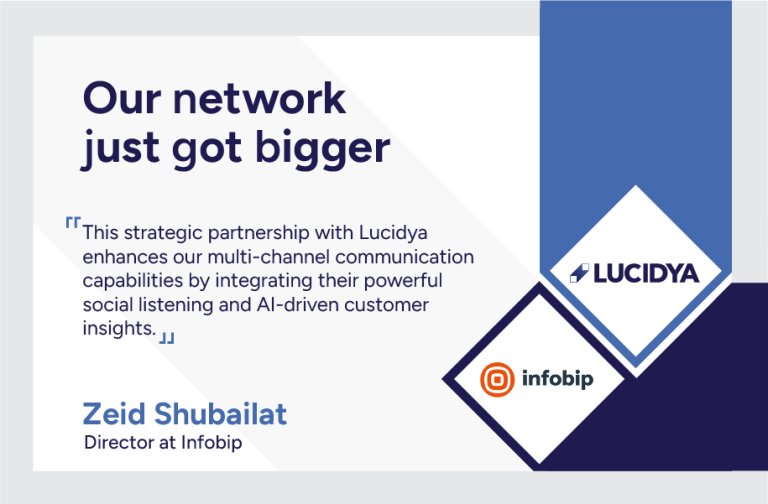
Culturally-Relevant AI: Balancing Innovation, Cultural Nuance, and Privacy in MENA
In MENA, AI often gets a sideways glance. It’s not a rejection of technology—far from it. The region is actually no stranger to technological innovation. But when it comes to AI, there’s a quiet question that lingers: Does it truly understand us?
The skepticism isn’t unfounded. Many AI tools feel like they were built for someone else—someone who speaks English, thinks in Western contexts, and operates in a regulatory environment that doesn’t quite match the complexities of MENA. Consider something as simple as a chatbot. It might greet you in flawless English, but the moment you switch Arabic—or, heaven forbid, a dialect—it stumbles awkwardly.
Today, AI is no longer a differentiator; it’s a standard feature. Chatbots, analytics, sentiment analysis—nearly every tool today claims to be powered by AI. Yet, despite the market being saturated with solutions, few deliver what MENA businesses truly need: cultural intelligence.
This disconnect is creating friction and breeding doubt among businesses and consumers alike. Companies are striving to leverage AI for customer engagement, only to find that most tools lack the localization required to address MENA’s cultural, linguistic, and regulatory intricacies. Consumers, for their part, are raising the bar with their expectations. They are actively on the lookout for innovative services that simplify their lives, but if these services feel like they were not designed with them in mind, they are quick to lose interest.
Applying one-size-fits-all strategies in a diverse and thriving region is a losing game. AI must catch up—and fast! But to do that, we need to toss out the old playbook.
In other words, MENA business leaders here must tackle a multi-faceted challenge: pushing forward with new ideas that fit the region’s linguistic diversity and honor its social fabric while keeping people’s privacy safe. It’s a tightrope walk, and generic AI only adds to the complexity. But it’s not beyond solving. What’s needed is a thoughtful approach—one that respects the region’s unique identity and needs while embracing the potential of AI. This isn’t about reinventing the wheel; it’s about making sure the wheel is designed with purpose for the road ahead. Because when AI truly adapts to the region, it won’t just be a tool—it’ll be a partner. And that’s when things really take off.
Beyond the hype: two paths to value
Last week, as soft snow blanketed the streets of Davos, the World Economic Forum delivered a headline-grabbing number that cut through the cold: $10 trillion. That’s the estimated value AI could generate globally as governments and businesses modernize. For leaders, the question is no longer whether to act—it’s how. How can organizations capture their share of this transformative opportunity?
It all depends on whether they will treat AI as infrastructure or an accessory. This is especially tricky in MENA, where cultural and operational complexity defies one-size-fits-all solutions. The choice made will determine who captures value and who incurs hidden costs.
AI at the core vs. AI as an add-on
In recent years, an influx of AI tools has hit the market, all promising their ability to “revolutionize” business operations. Despite the hype, many MENA companies hit a wall. The issue isn’t access to data or technology—it’s adaptation.
This brings us back to a fundamental truth: not all AI is created equal. Some of it feels like it was made for you. Some of it feels like it was made for someone else, then awkwardly handed to you. The difference is in how it’s built—and why.
The “why” is where strategy meets execution. To understand the implications and break things down simply, let’s call AI as an add-on “Tourist AI” and AI at the core “Native AI”. Tourist AI usually shows up with a map, follows a script, and tries to fit in. But it doesn’t truly get the place. While it can accomplish basic tasks, it remains disconnected from the deeper workings of an organization. Native AI, on the other hand, is a local. It knows the shortcuts, the unspoken rules, and the nuances that make all the difference.
As we examine these approaches more closely, let’s compare their key features and understand why the choice between them matters for businesses serving MENA customers:
| Tourist AI (Add-on) | Native AI (Core) |
|
Limited integration: Add-on AI might not fully integrate with existing systems, which leads to disjointed customer experiences where AI is only present in certain areas, not across the entire customer journey.
|
Integrated customer experience: When AI is central to a company’s strategy, it’s not just an add-on but is woven into every aspect of the business model, from product development to customer interaction. This allows for:
|
| Enhancement over innovation: Companies focus on adding AI features to existing products or services rather than developing their solutions, which often results in generic adaptations that fall short of effectively addressing the specific needs of the MENA market. | Innovation and adaptation: Companies can innovate new products or services that are inherently AI-driven, tailored specifically for the MENA market, thus addressing local needs more effectively. |
| Privacy and compliance challenges: Add-on solutions might struggle more with compliance, as they need to integrate with existing systems that might not have been designed with modern data protection in mind. | Data security and privacy: Since privacy is paramount, having AI at the core allows for the development of robust, built-in security measures that comply with local data protection laws. |
| Training and Adoption: There’s often a steeper learning curve for staff, as add-on AI might not be as seamlessly integrated into daily workflows, potentially affecting the quality of CX. | Employee empowerment: AI can assist or augment human roles rather than just replacing them. This leads to better job roles where employees work alongside AI to enhance customer interactions. |
| Upgrade and maintenance costs: Over time, maintaining separate AI systems can be more costly and less efficient than having AI as a core component of the business architecture. | Scalability and sustainability: Core AI can scale more efficiently with the business and adapt to growth or changes in market dynamics while ensuring sustainable practices. |
Despite these clear distinctions, too many organizations are defaulting to the former approach. In their rush to adopt AI, they’re overlaying tools built for other markets onto their local operations without meaningful adaptation or consideration of local needs. And it’s only after they’ve invested time, resources, and effort into adoption that they realize the mismatch.
This is so widespread that Gartner predicts 30% of generative AI initiatives abandoned by 2025, which reveals the scale of this problem. To address this, organizations operating or looking to operate in MENA may benefit from focusing on context-aware implementation. This means establishing AI adoption roadmaps that explicitly account for regional norms, compliance frameworks, and operational workflows before scaling. By anchoring initiatives in these realities, organizations can progress past the proof-of-concept stage and transition more effectively to sustainable deployment. The focus shifts from merely adopting AI to adapting it.
Two battles worth fighting to make AI work for MENA
MENA is a region of unparalleled potential. With a young, tech-savvy population and some of the world’s highest digital adoption rates, the opportunity for AI-driven growth is immense. But, as already mentioned, the region’s complexity demands more than off-the-shelf solutions.
The imbalance in AI strategy development begins with the language it is built on. The majority of large language models (LLMs), the driving force behind today’s AI advancements, are trained primarily on English-language data. With 52.1% of web content in English and a mere 0.6% in Arabic, this gap isn’t a coincidence; it’s a reflection of where the money, resources, and innovation have historically been concentrated.
So, for MENA, we’re facing two big challenges that only AI built into the core of businesses can solve:
-
Innovation vs. Privacy
The challenge: AI’s hunger for data can conflict with privacy rights, particularly in MENA where there’s heightened awareness of data misuse. The challenge is innovating with AI while ensuring personal data isn’t exploited or mishandled.
The limitations of Add-on AI: Although Add-on AI solutions can optimize existing systems, they are inherently limited. Without deep integration, they often provide fragmented insights, react rather than predict, and address privacy retroactively, which can introduce compliance risks. While this approach can work for many businesses, organizations should consider how well it aligns with their long-term goals for data-driven innovation and security.
The Native AI advantage: AI built into the core of business operations solves these challenges by embedding privacy and innovation into its foundation. Here’s how:
- Privacy by design: Instead of privacy being an afterthought, it’s integrated into every layer of AI system from inception. This approach aligns with the region’s stringent data protection laws and ensures individual privacy rights.
- Consent as ritual: In MENA, where community and familial bonds are strong, core AI can incorporate consent mechanisms that feel more like a cultural ritual than a legal requirement. This could involve periodic, clear communication about data use, reflecting the region’s value on respect and consultation.
- Unified intelligence: AI at the core provides a cohesive understanding of customer journeys across multiple touchpoints, which enables seamless and personalized experiences. By analyzing data comprehensively and securely, it delivers predictive and actionable insights and adaptive engagement strategies without exploiting personal information.
-
Scale vs. Cultural Relevance
The challenge: Businesses are under immense pressure to integrate AI solutions quickly to stay competitive. Scaling automated customer interactions across highly heterogeneous linguistic environments and multifaceted regulatory landscapes—while relying on AI architectures optimized for Western linguistic, cultural, and legal paradigms—introduces systemic localization failures. Customers sense when tools misunderstand their needs, use inappropriate language, or ignore local expectations, and this gradually erodes trust and loyalty.
The limitations of Add-on AI: Add-on AI creates experiences that feel transactional, not relational. It often prioritizes speed over depth, leading to surface-level localization that misses cultural nuances. Prebuilt rules may overlook how trust is built in different regions, while static cultural profiles can rely on outdated assumptions rather than adapting to evolving norms. For businesses focused on deep, meaningful engagement, considering AI solutions with more contextual awareness may be beneficial.
The Native AI advantage: Native AI closes the gap between convenience and connection by making empathy systemic. It replaces rigid, impersonal systems with fluid interactions that earn loyalty because they demonstrate understanding rather than just claiming it:
- Deep cultural context understanding: Instead of treating culture as a checkbox, Native AI embeds cultural norms into its decision-making process. It anticipates needs based on shared values—like prioritizing community-oriented solutions in collectivist markets or recognizing unspoken etiquette in customer disputes—to foster respect and relevance.
- Dialect-aware analysis: Built on local research and developed in partnership with regional linguists, Native AI decodes subtle shifts in tone, formality, and intent unique to the region. For example, it identifies when an informal expression invites a relaxed exchange versus when it risks seeming disrespectful. It ensures responses align with unwritten cultural rules, like balancing warmth with professionalism to maintain trust.
- Regional sentiment adaptation: By continuously learning from local feedback and behavioral cues, Native AI adjusts its approach in real time. It avoids tone-deaf promotions during sensitive periods, tailors urgency in resolving complaints, and mirrors the emotional cadence customers expect—turning every interaction into a reflection of their lived experience.
Leading the way forward: AI at the core, Arabic-first, and culturally connected
At Lucidya, we harness AI to help brands truly connect with their customers across the MENA region. That’s why we’ve built our technology from the ground up to understand the heartbeat of the MENA region: its languages, culture, and values. Here’s how we’re redefining AI to work for you, not just around you:
- Culturally intelligent AI:
- How: Our AI-powered platform doesn’t just process data—it listens, learns, and understands. It is built from the ground up with natural language processing (NLP) to understand the nuances of Arabic—its dialects, slang, and cultural context. With 92% accuracy in analyzing 15 Arabic dialects, Lucidya ensures that every customer interaction feels personal and relevant. Whether it’s social media conversations, customer feedback, or market trends, we help businesses engage in ways that resonate deeply.
- Why: Because a customer in Egypt doesn’t speak the same way as a customer in Saudi Arabia, and a campaign that resonates in Jordan might fall flat in Kuwait. Lucidya’s AI ensures that businesses don’t just communicate—they connect. It’s the difference between being heard and being understood.
- Privacy and Security:
- How: We’ve woven privacy and security into the very fabric of our platform. From using the latest encryption to being fully compliant with regional regulations like SDAIA PDPL and global standards like GDPR, Lucidya ensures that every piece of data is handled with the utmost care and transparency.
- Why: Because in a region where trust is earned through actions, not words, Lucidya gives businesses the confidence to operate securely. For customers, it’s the reassurance that their information is safe—a foundation for lasting relationships.
- Empowering Local Businesses:
- How: Lucidya offers scalable, user-friendly AI solutions that can be seamlessly integrated into existing business systems, enabling even SMEs to leverage AI without extensive tech resources.
- Why: This democratization of AI technology means that innovation isn’t just for large corporations. By equipping local businesses of all sizes with the power of AI, Lucidya supports economic growth and competitiveness in the global market.
- Engagement and Trust Building:
- How: By combining our real-time social listening and sentiment analysis capabilities with our advanced customer support solutions, we allow businesses to hear what their customers are saying, respond with empathy, and act with purpose. From spotting trends to resolving issues, Lucidya ensures that every interaction strengthens the bond between businesses and their customers.
- Why: Because in a region where business is deeply rooted in trust and personal rapport, losing touch with customers means missing opportunities to grow and thrive. Lucidya equips businesses to actively listen, respond with empathy, and act on customer insights in real time; it helps them nurture the very relationships that are crucial to thriving in this unique market.
Why this matters to you
Built for MENA, loved by MENA: Lucidya isn’t a global solution “adapted” for the region—it’s born here. Our unified AI-powered CXM platform is designed to navigate the cultural, linguistic, legal, and business nuances that make the MENA region unique.
Future-proof without the fuss: Stay ahead of trends (and competitors) with AI that evolves as fast as your market does—without risking cultural missteps or privacy fires. Lucidya ensures that your business is always ready to meet changing customer expectations, no matter how quickly they shift.
Do good, do well: Choosing Lucidya means supporting homegrown tech that respects the region’s values. It’s not just business—it’s pride. By partnering with us, you’re contributing to the growth of a tech ecosystem that serves the region and its people.
AI for the region, by the region: When we talk about integrating AI into customer experience in MENA, we’re talking about something deeper than just making things faster or flashier. This is a region with its own beautiful ways of speaking, thinking, and living, and our AI needs to reflect that. It’s frustrating how often AI tools feel like outsiders here, stumbling through Arabic and missing those small but important cultural touches that help people connect. We need to do better. We need AI solutions that feel at home in MENA, and that get the local dialects, respect the cultural values, and build the kind of trust that matters so much in this part of the world.
So, where do we go from here? We move beyond generic, one-size-fits-all solutions and focus on integrating AI that’s as diverse and dynamic as the region itself. This is what we’ve built at Lucidya: a unified AI-powered CXM engineered to navigate the unscripted. Not just language, but intent. Not just data, but context.
We start with MENA’s DNA—and let the world catch up.
Ready to see how Lucidya can turn insights into impact? Request a demo today and discover how our Arabic-first, AI-powered CXM platform can help you:
- Engage customers in their language, with 92% accuracy across dialects.
- Build trust with privacy-first, ethically designed tools.
- Drive growth while supporting homegrown innovation.
The future of customer experience isn’t just coming—it’s here. Let’s shape it together!









